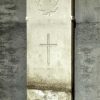Transcript: Memorial Hall
Welcome to this Remembrance guided tour stop at the Canadian War Museum. My name is Shalina and I’m a museum interpreter.
The building that we’re standing in is a place where architecture, artifacts and exhibitions work together to help us understand war and its impact on all Canadians, past and present. It’s a place where we come to remember.
The War Museum is not just a place to preserve and share the story of Canada’s military past. It’s part of that story. If these walls could talk, what would they say? Let’s take a closer look at how the message of remembrance is intertwined with the architecture all around us.
The War Museum’s exhibitions are filled with stories of service and sacrifice. They present war as a devastating human experience. The information is important, but it can be overwhelming. Sometimes, visitors need a break to reflect on what they’ve seen and learned.
This is Memorial Hall, a quiet refuge inside the museum. It’s a place for reflection.
Seemingly isolated from the rest of the world, this small room made of concrete and slate houses a reflecting pool, a bench and a single artifact.
Everything about this room feels different from the rest of the Museum. The galleries can be loud and disorienting, but in here it’s silent and soberingly sparse.
The walls are smooth, straight and square. The rectangular pattern on these walls reminds us of the rows of white headstones marking the graves of Canadians buried overseas.
This leads us back to the focal point of this room, the only artifact it contains: the headstone of the Unknown Soldier.
You may be wondering how the headstone ended up here.
During the world wars, thousands of Canadians were killed overseas and buried without being identified. In May 2000, one of them, from a First World War cemetery near Vimy Ridge, was selected to be returned to Canada and placed in a tomb at the National War Memorial.
The headstone from his original burial plot was donated to the Canadian War Museum. When the museum opened in this location in 2005, the headstone was given a place of honour, here in Memorial Hall.
Why was this room designed around a tombstone? What makes a tombstone a suitable focal point for a space of contemplation? War is destructive and brutal, and leads to an enormous loss of life. Since the First World War, more than 115,000 Canadians have been killed in wars. Those losses were felt in families and communities across the country. But when numbers get that big, they can be hard to comprehend. Sometimes, it helps to start with a single person.
The Unknown Soldier is uniquely suited to that role. With no known name, no known hometown, he symbolizes any one of Canada’s fallen.
Visitors to this space can look at this headstone as they think about war and what it means for Canadians, past, present and future.
Memorial Hall is open to our visitors any time they need a space for quiet contemplation. But it takes on a special significance one day every year, on Remembrance Day.
The window across from the headstone was positioned in such a way that, at 11 a.m. each November 11th, when the sun shines through it, the beam of light falls directly on the headstone of the Unknown Soldier.
It’s hard to put into words why that moment is so poignant, but there is something truly moving about the experience. Perhaps it’s the amount of thought and careful planning that went into constructing that annual moment of reflection.
Remembrance permeates Memorial Hall, a space where people come to consider the country’s sacrifices, on Remembrance Day and beyond.
 Historical Overview
Historical Overview
 Artifact
Artifact
 Video
Video
 Video
Video